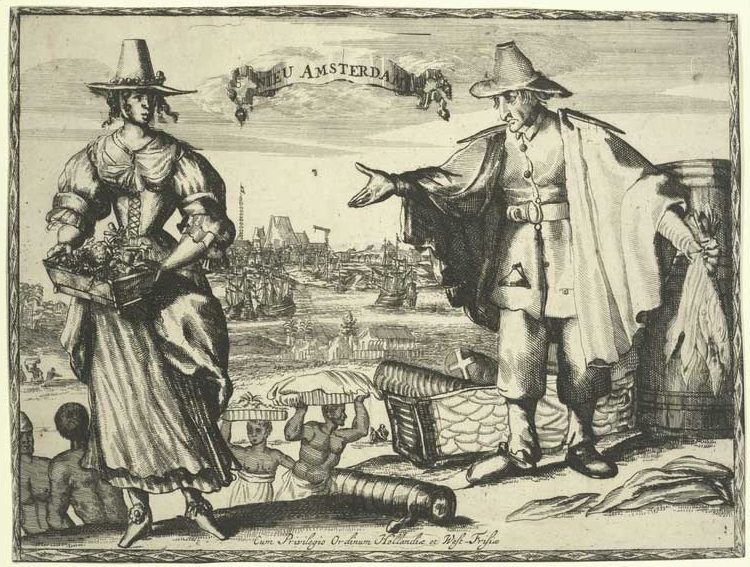
The engraving above is from the collections of the New York Public Library. The engraver was Aldert Meijer, and there is another very similar image titled Engelse Quakers en tabak planters aende Barbados which was published later. This copper engraving is believed to be one of the oldest representations of New Amsterdam, ca. 1640. It is part of the Stokes Collection: Citation/reference : Stokes P.1642-43, B-10.
Many enslaved people were held in bondage by merchants, farmers, householders and traders rather than the DWIC. This is known as private slavery. By the 1650's, there were more privately held enslaved people in New Amsterdam than those enslaved by the DWIC.
"New Amsterdam’s enslaved blacks were essentially the colony’s first municipal labor force. Those who were owned by the DWIC, as well as privately owned slaves, cleared forests and fields, constructed roads, and helped build fortifications like Fort Amsterdam and the Wall (later Wall Street) which spanned the island from the Hudson River to the East River. Typically, women worked as cooks, farm workers, mill laborers and performed household chores." Chris Moore, NYPL
The documents also show that Indigenous People, listed as 'Indians' in the documents were sold as slaves to individual households. https://encyclopedia.nahc-mapping.org/document/account-indians-sold-new-york-james-barre Ship manifests show some of them as having been sent to the Caribbean Islands. This happened often enough that there are documents that prohibit the taking of slaves from the Native American Tribes.
"The first slaves came to Manhattan via the Caribbean. They had been captured from Spanish and Portuguese slave ships. It was not until 1654 that the first consignment of slaves coming directly from Africa arrived. After that only a few more attempts were made to organize a direct slave trade with Africa. In August 1664, a few days before the English takeover of Manhattan, the Gideon arrived with 290 slaves from Angola on board. In a single go this virtually doubled the number of slaves. The slaves' tasks included woodcutting, clearing land, burning lime and working the land. They also transported the stones needed to build the church and the fort. " New Amsterdam, New York by Martine Gosselink
"In the 1650's a slave cost between 140 and 375 guilders. Later the demand for slaves in New Netherland increased and prices rose. In 1664 a slave cost some 600 guilders." New Amsterdam, New York by Martine Gosselink p 209
'In 1639 about one hundred blacks worked in the colony, a number that grew to approximately 250 in 1664 and was doubled by the arrival of 291 slaves on the ship Gideon in August. In that year, blacks, both free and enslaved, made up between 6 and 8 percent of the population with a concentration in New Amsterdam where it may be been 10 to 17 percent.' The Colony of New Netherland, Jaap Jacobs p. 55.
In 1638, there were as many as 60 Africans in New Amsterdam, totaling a fifth of the population. One would reckon that in 1660 (our target year) there were probably slightly under 200, totaling perhaps almost 10% of the population. (I'm basing this on the figures given by Jaap that there were c. 500 in the colony in 1664, with 291 of those having arrived on the Gideon in August of that year, so c. 500 minus 291 = c. 200 for 1660, with the bulk of them in New Amsterdam). NAHC Scholarly Review Committee Notes.
The word slave in English derives from 'Slavonic captive' because so many Slavonic peoples were taken as slaves in the 9th century. Slavery in New Netherland was not restricted to the capture and importation of Africans.
For more information on Slavery in New Netherland, please see Andrea Mosterman’s digital exhibit for the New Netherland Institute: https://www.newnetherlandinstitute.org/history-and-heritage/digital-exhibitions/slavery-exhibit/
For more information please see historian Lavada Nahon’s interview here: https://www.hhlt.org/lavada-nahon/
Additional reading:
Spaces of Enslavement, A History of Slavery and Resistance in Dutch New York, by Andrea C. Mosterman
https://www.cornellpress.cornell.edu/book/9781501715624/spaces-of-enslavement/#bookTabs=1
Bound by Bondage: Slavery and the Creation of a Northern Gentry, by Nicole Saffold Maskiell
https://www.google.com/books/edition/Bound_by_Bondage/4_lBEAAAQBAJ?hl=en&gbpv=1&printsec=frontcover
New Amsterdam, New York by Martine Gosselink
http://www.amazon.com/York-Amsterdam-Dutch-Origins-Manhattan/dp/9046804488/ref=sr_1_1?ie=UTF8&s=books&qid=1279471588&sr=1-1
The Colony of New Netherland, Jaap Jacobs
http://www.amazon.com/Colony-New-Netherland-Settlement-Seventeenth-Century/dp/0801475163/ref=sr_1_1?ie=UTF8&s=books&qid=1279471679&sr=1-1

